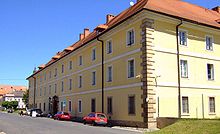
The Theresienstadt Papers (in German original Theresienstadt-Konvolut) are a collection of historical documents of the Jewish self-government of Theresienstadt concentration camp. These papers include an "A list" of so-called "prominents" interned in the camp and a "B-list" created by the Jewish Elders themselves. The Theresienstadt papers include two albums with biographies and many photographs, 64 watercolors and drawings from prisoners in Theresiendstadt, and the annual report of the Theresienstadt Central Library.[1] The papers were preserved at the liberation of the camp in May 1945 by Theresienstadt librarian Käthe Starke-Goldschmidt and later loaned to the Altona Museum for Art and Cultural History in Hamburg by her son Pit Goldschmidt.[2][3] The collection was opened for viewing by the public in 2002 at the Heine Haus branch of the Altona Museum.[4]
- ^ Das Theresienstadt-Konvolut auf www.ghetto-theresienstadt.info
- ^ Meyer, Beate (30 September 2013). A Fatal Balancing Act: The Dilemma of the Reich Association of Jews in Germany, 1939–1945. Berghahn Books. p. 319. ISBN 9781782380283.
- ^ Axel Feuß: Das Theresienstadt-Konvolut. Hamburg/München 2002, S. 5 f.
- ^ Neues Museum zeigt Ausstellung zur jüdischen Geschichte „Das Theresienstadt-Konvolut“, in Die Welt vom 15. Februar 2002
© MMXXIII Rich X Search. We shall prevail. All rights reserved. Rich X Search
